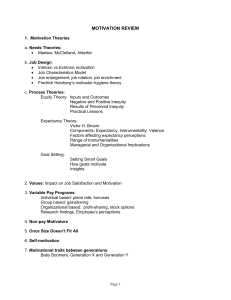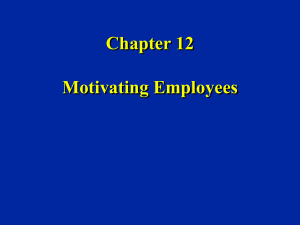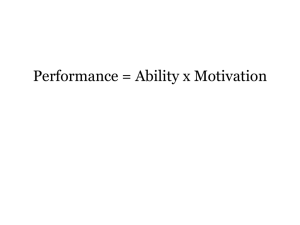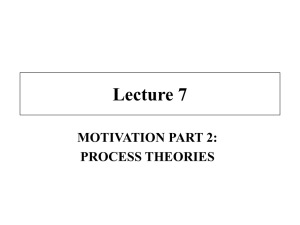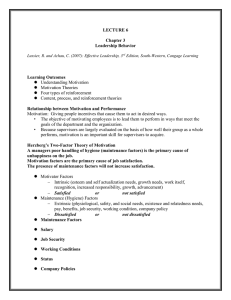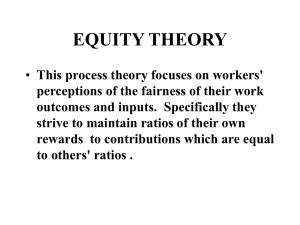Intrinsic and Extrinsic Needs and Rewards
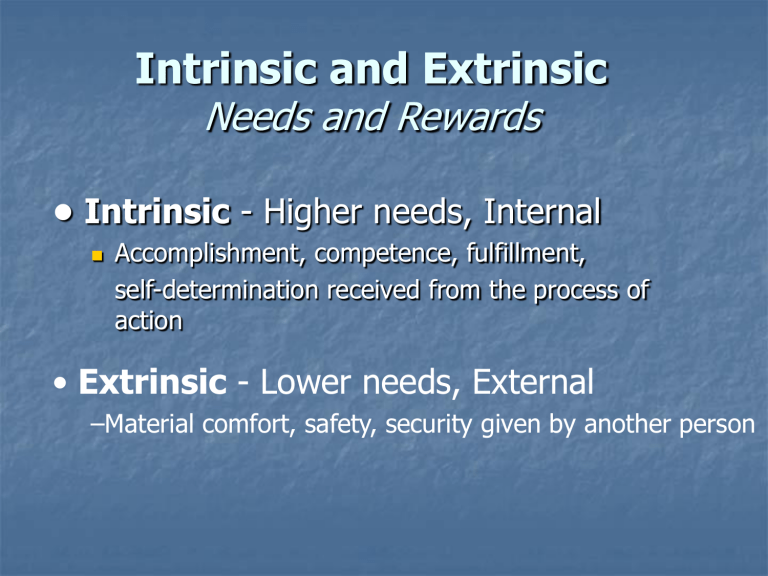
Intrinsic and Extrinsic
Needs and Rewards
• Intrinsic - Higher needs, Internal
Accomplishment, competence, fulfillment, self-determination received from the process of action
• Extrinsic - Lower needs, External
–Material comfort, safety, security given by another person
Content vs. Process Motivation
Theories
Content theories
explain why people have different needs at different times
Process theories
describe the processes through which needs are translated into behavior. Process theories try to explain why and how people are motivated.
Basic Model of Motivation
Needs Hierarchy Theory
Needs Hierarchy
Theory
Self-
Actualization
Esteem
Belongingness
Safety
Physiological
Maslow arranged five needs in a hierarchy
Satisfaction-progression process
People who experience selfactualization desire more rather than less of this need
Maslow’s Hierarchy of Needs
Acquired Needs Theory by David McClelland
Need for Achievement Desire to accomplish something difficult, attain high standards of success, master complex tasks, surpass others
Need for Affiliation Desire to form close personal relationships and friendships, avoid conflict
Need for Power Desire to influence or control others, be responsible and have authority over others
Frederick Herzberg Two-Factor Theory
Highly
Satisfied Motivators
Achievement
Recognition
Responsibility
Work itself
Personal growth
Motivators influence level of satisfaction
Neither
Hygiene
Factors
Work Conditions
Pay/security
Company Policy
Supervisors
Interpersonal Rel.
Hygiene factors influence level of dissatisfaction
Highly
Dissatisfied
Implications of Content Theories
Balance competition/cooperation by rewarding individual achievement and teamwork
Offer employees a choice of rewards
people have different needs at different times
Support the drive to learn by providing new learning opportunities
Don’t rely too much on financial rewards
Key Elements of
Expectancy Theory
E -- P expectancy
Effort ----- Performance
Will putting effort into the task lead to the desired performance?
P -- O expectancy
Performance ----- Outcomes
Will high performance lead to the desired outcome?
Valance - value of outcomes
(Pay, recognition, other rewards)
Are the available outcomes highly valued?
MOTIVATION
Assumptions - Expectancy
Workers are motivated to receive positive outcomes and avoid negative ones
Workers are rational, careful processors of information
Workers can make choices about how they behave, act, and how much effort they exert
Expectancy Theory in Practice
Increasing the E-to-P expectancy
training, selection, resources, clarify roles, provide coaching and feedback
Increasing the P-to-O expectancy
Measure performance accurately, explain how rewards are based on past performance
Increasing outcome valences
Use valued rewards, individualize rewards, minimize countervalent outcomes
Equity Defined
A State of psychological comfort
Exists when an individual’s input to outcome ratio is equal to the ratio of the comparison other
Elements of Equity Theory
Outcome/input ratio
inputs -- what employee contributes (e.g. skill) outcomes -- what employees receive (e.g. pay)
Comparison other
person/people we compare ratio with not easily identifiable
Equity evaluation
compare outcome/input ratio with the comparison other
Overreward vs Underreward
Inequity
Comparison
Other
You
Outcomes
Overreward
Inequity
Outcomes
Inputs Inputs
Underreward
Inequity
Outcomes
Inputs
Outcomes
Inputs
Consequences of Inequity
Change inputs
Change outcomes
Change perceptions
Leave the field
Act on the comparison other
Change the comparison other
Equity Sensitivity
Benevolents
Tolerant of being underrewarded
Equity Sensitives
Want ratio to be equal to the comparison other
Entitleds
Prefer receiving proportionately more than others
Goals are Motivational
Because you can choose where you want to go
You know exactly what to do
Can provide short and long term vision
Fosters planning and resource evaluation
Effective Goal Setting
Specific
Relevant
Challenging
Commitment
Participation
Challenging
Task
Effort
Task
Performance
High
Effect of Goal Difficulty on
Performance
Area of
Optimal
Goal
Difficulty
Low Moderate Challenging
Goal Difficulty
Impossible
Outcomes of Goal Setting
Greater productivity and sales
Improved performance
Improved self-confidence
Increases motivation to achieve
Increases pride and satisfaction
Helps reduce negative attitudes toward work/increases morale
Research Suggests: Those who use Goal Setting
Suffer less from stress and anxiety
Concentrate better
Show more self-confidence
Perform better
Are more satisfied with their jobs
Behavior Modification
We “operate” on the environment
Alter behavior to maximize positive and minimize adverse consequences. Behavior is a function of its consequences
Operant means voluntary or learned behavior as opposed to reflexive or unlearned behavior
Law of effect
Likelihood that an operant behavior will be repeated depends on its consequences
A-B-Cs of Behavior Modification
Antecedents
What happens before behavior
Behavior
What person says or does
Consequences
What happens
After behavior
Example
Attendance bonus system is announced
Employee attends scheduled work
Employee receives attendance bonus
Reinforcement Perspective on Motivation
Positive Reinforcement – increase strength and frequency of a behavior by providing something pleasing
Negative Reinforcement – increase strength and frequency of a behavior by the removal or avoidance of a consequence (stop criticizing and good performance results)
Punishment – decrease strength and frequency of a behavior by giving the employee something displeasing or taking away something pleasing
Extinction – decrease strength and frequency of a behavior by providing no consequence
Contingencies of Reinforcement
Consequence is Introduced
No
Consequence
Consequence is Removed
Behavior
Increases/
Maintained
Positive reinforcement
Negative reinforcement
Behavior
Decreases
Punishment Extinction Punishment
Behavior Modification
Limitations
Can’t reinforce nonobservable behavior
Reinforcer tends to wear off
Variable ratio schedule is a form of gambling
Ethical concerns about perceived manipulation
Organizationwide
Motivational Programs
Employee ownership Psychological, stock
Pay for knowledge Skills possessed
Gainsharing Teamwork
Pay for performance Results
Job enrichment High level, more tasks

